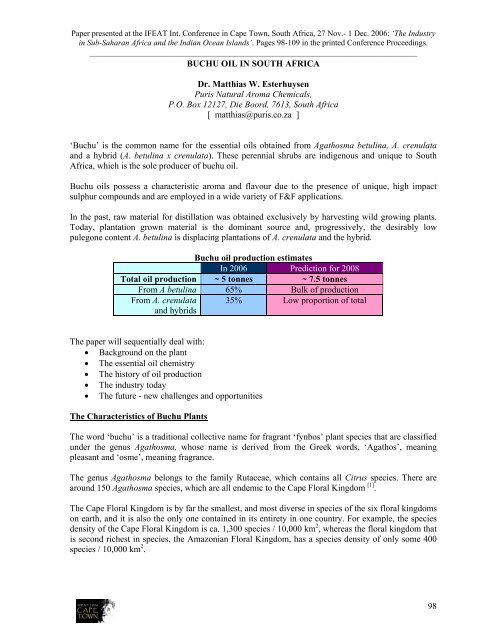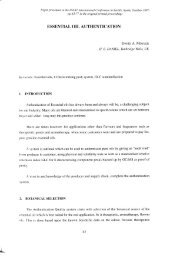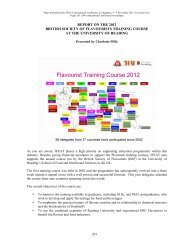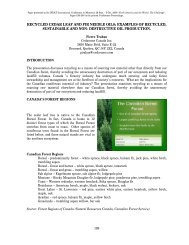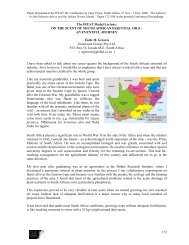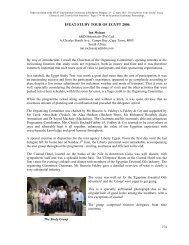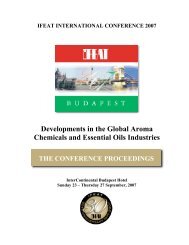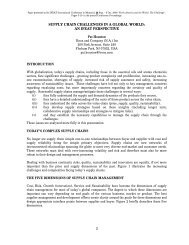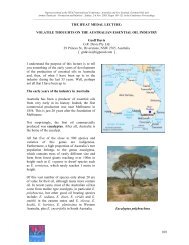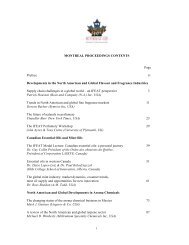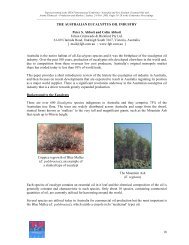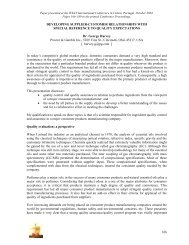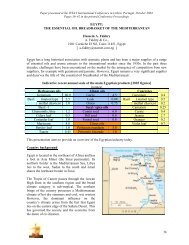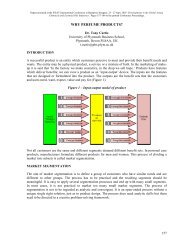Paper presented at the IFEAT Int. Conference in Cape Town
Paper presented at the IFEAT Int. Conference in Cape Town
Paper presented at the IFEAT Int. Conference in Cape Town
Create successful ePaper yourself
Turn your PDF publications into a flip-book with our unique Google optimized e-Paper software.
<strong>Paper</strong> <strong>presented</strong> <strong>at</strong> <strong>the</strong> <strong>IFEAT</strong> <strong>Int</strong>. <strong>Conference</strong> <strong>in</strong> <strong>Cape</strong> <strong>Town</strong>, South Africa, 27 Nov.- 1 Dec. 2006: ‘The Industry<strong>in</strong> Sub-Saharan Africa and <strong>the</strong> Indian Ocean Islands’. Pages 98-109 <strong>in</strong> <strong>the</strong> pr<strong>in</strong>ted <strong>Conference</strong> Proceed<strong>in</strong>gs._________________________________________________________________________________BUCHU OIL IN SOUTH AFRICADr. M<strong>at</strong>thias W. EsterhuysenPuris N<strong>at</strong>ural Aroma Chemicals,P.O. Box 12127, Die Boord, 7613, South Africa[ m<strong>at</strong>thias@puris.co.za ]‘Buchu’ is <strong>the</strong> common name for <strong>the</strong> essential oils obta<strong>in</strong>ed from Ag<strong>at</strong>hosma betul<strong>in</strong>a, A. crenul<strong>at</strong>aand a hybrid (A. betul<strong>in</strong>a x crenul<strong>at</strong>a). These perennial shrubs are <strong>in</strong>digenous and unique to SouthAfrica, which is <strong>the</strong> sole producer of buchu oil.Buchu oils possess a characteristic aroma and flavour due to <strong>the</strong> presence of unique, high impactsulphur compounds and are employed <strong>in</strong> a wide variety of F&F applic<strong>at</strong>ions.In <strong>the</strong> past, raw m<strong>at</strong>erial for distill<strong>at</strong>ion was obta<strong>in</strong>ed exclusively by harvest<strong>in</strong>g wild grow<strong>in</strong>g plants.Today, plant<strong>at</strong>ion grown m<strong>at</strong>erial is <strong>the</strong> dom<strong>in</strong>ant source and, progressively, <strong>the</strong> desirably lowpulegone content A. betul<strong>in</strong>a is displac<strong>in</strong>g plant<strong>at</strong>ions of A. crenul<strong>at</strong>a and <strong>the</strong> hybrid.Buchu oil production estim<strong>at</strong>esIn 2006 Prediction for 2008Total oil production ~ 5 tonnes ~ 7.5 tonnesFrom A betul<strong>in</strong>a 65% Bulk of productionFrom A. crenul<strong>at</strong>aand hybrids35% Low proportion of totalThe paper will sequentially deal with:• Background on <strong>the</strong> plant• The essential oil chemistry• The history of oil production• The <strong>in</strong>dustry today• The future - new challenges and opportunitiesThe Characteristics of Buchu PlantsThe word ‘buchu’ is a traditional collective name for fragrant ‘fynbos’ plant species th<strong>at</strong> are classifiedunder <strong>the</strong> genus Ag<strong>at</strong>hosma, whose name is derived from <strong>the</strong> Greek words, ‘Ag<strong>at</strong>hos’, mean<strong>in</strong>gpleasant and ‘osme’, mean<strong>in</strong>g fragrance.The genus Ag<strong>at</strong>hosma belongs to <strong>the</strong> family Rutaceae, which conta<strong>in</strong>s all Citrus species. There arearound 150 Ag<strong>at</strong>hosma species, which are all endemic to <strong>the</strong> <strong>Cape</strong> Floral K<strong>in</strong>gdom [1] .The <strong>Cape</strong> Floral K<strong>in</strong>gdom is by far <strong>the</strong> smallest, and most diverse <strong>in</strong> species of <strong>the</strong> six floral k<strong>in</strong>gdomson earth, and it is also <strong>the</strong> only one conta<strong>in</strong>ed <strong>in</strong> its entirety <strong>in</strong> one country. For example, <strong>the</strong> speciesdensity of <strong>the</strong> <strong>Cape</strong> Floral K<strong>in</strong>gdom is ca. 1,300 species / 10,000 km 2 , whereas <strong>the</strong> floral k<strong>in</strong>gdom th<strong>at</strong>is second richest <strong>in</strong> species, <strong>the</strong> Amazonian Floral K<strong>in</strong>gdom, has a species density of only some 400species / 10,000 km 2 .98
The <strong>Cape</strong> Floral K<strong>in</strong>gdom, often also referred to as ‘Fynbos’ due to <strong>the</strong> f<strong>in</strong>e shrubby n<strong>at</strong>ure of most ofits ca. 8,700 species, ranges over a narrow band (~60km wide) along <strong>the</strong> South Western <strong>Cape</strong> coastl<strong>in</strong>efrom ~200km north of <strong>Cape</strong> <strong>Town</strong> to Port Elizabeth, ~700km to <strong>the</strong> east of <strong>Cape</strong> <strong>Town</strong>. In general‘Fynbos’ veget<strong>at</strong>ion is characterised by many low bushy shrub-like plants and few trees [2] .N<strong>at</strong>ural occurrenceTypical Fynbos scene The n<strong>at</strong>ural ranges for A. betul<strong>in</strong>a and A.crenul<strong>at</strong>a are, however, much smaller than <strong>the</strong>total <strong>Cape</strong> Floral K<strong>in</strong>gdom range and also aregeographically separ<strong>at</strong>ed:• N<strong>at</strong>ural A. betul<strong>in</strong>a occurs <strong>in</strong> mounta<strong>in</strong>ousregions from Gouda northwards to Piketberg,Aurora <strong>in</strong> <strong>the</strong> west to <strong>the</strong> Cederbergmounta<strong>in</strong>s nor<strong>the</strong>ast of Piketberg [3] .• A. crenul<strong>at</strong>a is found n<strong>at</strong>urally <strong>in</strong> an evensmaller area, rang<strong>in</strong>g from <strong>the</strong> HottentotsHolland mounta<strong>in</strong>s around Somerset-West <strong>in</strong><strong>the</strong> south to <strong>the</strong> mounta<strong>in</strong>s around Tulbagh,~100km to <strong>the</strong> north.• The n<strong>at</strong>ural occurrence of <strong>the</strong> third “species”,A. betul<strong>in</strong>a x crenul<strong>at</strong>a (or hybrid buchu), isrel<strong>at</strong>ively unclear.Two phenotypically <strong>in</strong>dist<strong>in</strong>guishable chemotypes of A. betul<strong>in</strong>a have been described [3] :• an isomenthone chemotype th<strong>at</strong> is ma<strong>in</strong>ly found <strong>in</strong> <strong>the</strong> wild <strong>in</strong> <strong>the</strong> Piketberg region, and• a diosphenol chemotype th<strong>at</strong> occurs n<strong>at</strong>urally only <strong>in</strong> <strong>the</strong> eastern portion of A. betul<strong>in</strong>a’srange, <strong>in</strong> <strong>the</strong> Cederberg mounta<strong>in</strong>s.The hybridThere is a school of thought th<strong>at</strong> ascribes <strong>the</strong> emergence of <strong>the</strong> hybrid, A. betul<strong>in</strong>a x crenul<strong>at</strong>a, to <strong>the</strong>plant<strong>in</strong>g of cultiv<strong>at</strong>ed A. betul<strong>in</strong>a and A. crenul<strong>at</strong>a plants <strong>in</strong> <strong>the</strong> same fields by early buchu farmers.Ano<strong>the</strong>r school of thought describes it not as a true hybrid species, but r<strong>at</strong>her as a unique popul<strong>at</strong>ion orchemotype of A. crenul<strong>at</strong>a (s<strong>in</strong>ce phenotypically, adult A. betul<strong>in</strong>a x crenul<strong>at</strong>a plants usually havemuch more <strong>in</strong> common with A. crenul<strong>at</strong>a than A. betul<strong>in</strong>a, and <strong>the</strong> chemistry of its essential oil is99
much closer rel<strong>at</strong>ed to th<strong>at</strong> of A. crenul<strong>at</strong>a, although it does conta<strong>in</strong> elements of A. betul<strong>in</strong>a oil aswell). A third school of thought doubts its existence altoge<strong>the</strong>r, ascrib<strong>in</strong>g <strong>the</strong> chemistry of a buchu oilconta<strong>in</strong><strong>in</strong>g characteristics of both species to <strong>the</strong> distill<strong>at</strong>ion of both A. betul<strong>in</strong>a and A. crenul<strong>at</strong>a plants<strong>in</strong> one b<strong>at</strong>ch. S<strong>in</strong>ce <strong>the</strong> identific<strong>at</strong>ion of all <strong>the</strong> components found <strong>in</strong> buchu oil <strong>in</strong> 1975 [4] and <strong>the</strong>development of accur<strong>at</strong>e analytical GC analyses of buchu oils obta<strong>in</strong>ed from s<strong>in</strong>gle plants with<strong>in</strong>South Africa <strong>in</strong> <strong>the</strong> early 1990s, it has been shown th<strong>at</strong> A. betul<strong>in</strong>a x crenul<strong>at</strong>a certa<strong>in</strong>ly does exist.Whe<strong>the</strong>r it is a true hybrid, or a popul<strong>at</strong>ion / chemotype of A. crenul<strong>at</strong>a still rema<strong>in</strong>s unclear.It has to be stressed th<strong>at</strong>, due to cultiv<strong>at</strong>ion of buchu, and <strong>the</strong> small area <strong>in</strong> which it successfully grows,<strong>the</strong> n<strong>at</strong>ural ranges of each of <strong>the</strong> species described here do not reflect <strong>the</strong> cultiv<strong>at</strong>ed ranges well. Theold habit of obta<strong>in</strong><strong>in</strong>g buchu seeds or plant m<strong>at</strong>erial only from a certa<strong>in</strong> area as an assurance of itsgenetic identity is <strong>the</strong>refore a very risky venture <strong>in</strong>deed.Morphological characteristicsThe three species of buchu th<strong>at</strong> are currently cultiv<strong>at</strong>ed for essentialoil production are perennial shrubs with woody branches and smalldotted leaves and <strong>the</strong>y are sometimes difficult to dist<strong>in</strong>guish fromeach o<strong>the</strong>r with<strong>in</strong> <strong>the</strong> first year of growth.At <strong>the</strong> m<strong>at</strong>ure stage:• A. betul<strong>in</strong>a displays a round leaf and is commonly knownas ‘round leaf buchu’; while• A. crenul<strong>at</strong>a has an oval leaf and is called as such.Botanical draw<strong>in</strong>gs of buchu leafshapes for commercial species A. betul<strong>in</strong>aA. crenul<strong>at</strong>a100
Species identity <strong>in</strong> plant<strong>at</strong>ionsBecause veget<strong>at</strong>ive propag<strong>at</strong>ion wasnot developed until recently, all of<strong>the</strong> early buchu plant<strong>at</strong>ions wereestablished us<strong>in</strong>g <strong>in</strong>dividualseedl<strong>in</strong>gs and <strong>the</strong>re has often beengre<strong>at</strong> confusion regard<strong>in</strong>g geneticidentity of many plant<strong>at</strong>ions [6] .In particular, A. crenul<strong>at</strong>a and <strong>the</strong>hybrid A. betul<strong>in</strong>a x crenul<strong>at</strong>a plantsare practically identical, even beyond<strong>the</strong> seedl<strong>in</strong>g stage.To add to this confusion, <strong>the</strong> two phenotypically <strong>in</strong>dist<strong>in</strong>guishable chemotypes of A. betul<strong>in</strong>a (adiosphenol and an isomenthone chemotype), with drastically different essential oil compositions, areoften found mixed <strong>in</strong> plant<strong>at</strong>ions.These factors, toge<strong>the</strong>r with competitive behaviour of some oil distillers and <strong>the</strong> lack of sufficientanalytical facilities, have caused gre<strong>at</strong> confusion regard<strong>in</strong>g <strong>the</strong> production of <strong>the</strong> <strong>in</strong>dividual species andchemotypes of buchu oil. Many a farmer has ended up with a beautiful field of cultiv<strong>at</strong>ed A. crenul<strong>at</strong>aplant m<strong>at</strong>erial <strong>in</strong>stead of <strong>the</strong> more valuable A. betul<strong>in</strong>a th<strong>at</strong> he <strong>in</strong>tended to cultiv<strong>at</strong>e, ditto regard<strong>in</strong>g <strong>the</strong>chemotypes of A. betul<strong>in</strong>a.Fur<strong>the</strong>rmore, <strong>the</strong>se confusions have even filtered through to <strong>the</strong> oil market with <strong>the</strong> result th<strong>at</strong> eventoday some of <strong>the</strong> largest traditional users of buchu oil for flavour and fragrance applic<strong>at</strong>ions havespecific<strong>at</strong>ions for ‘Betul<strong>in</strong>a buchu oil’, which is <strong>in</strong> fact obta<strong>in</strong>ed from A. crenul<strong>at</strong>a, or worse a ‘secret’mixture of A. betul<strong>in</strong>a and A. crenul<strong>at</strong>a.The species buchu oil th<strong>at</strong> a client requires is sometimes not mentioned <strong>at</strong> all, thus putt<strong>in</strong>g <strong>the</strong> onus on<strong>the</strong> distiller to exhaustively m<strong>at</strong>ch a specific client’s specific<strong>at</strong>ion. Even when ‘Betul<strong>in</strong>a buchu oil’ isrequested, <strong>the</strong> chemotype is never known until a sample is approved. Clearly this situ<strong>at</strong>ion is not ideal.<strong>Int</strong>erest<strong>in</strong>gly, it is our experience th<strong>at</strong> very rarely are pure forms of ei<strong>the</strong>r chemotypes of A. betul<strong>in</strong>arequired.There is currently no ISO standard for buchu oil(s), and only general CAS and FEMA numbers (CAS:68650-46-4; FEMA: 2169) are assigned to ‘Buchu oil’, represent<strong>in</strong>g all <strong>the</strong> various types and speciesof buchu oil available.Essential oil chemistryModern gas-chrom<strong>at</strong>ographic analyses have made <strong>the</strong> identific<strong>at</strong>ion of <strong>the</strong> exact species / chemotypeof buchu plant m<strong>at</strong>erial a rout<strong>in</strong>e exercise.A. betul<strong>in</strong>a (both chemotypes), A. crenul<strong>at</strong>a and A. betul<strong>in</strong>a x crenul<strong>at</strong>a essential oils all conta<strong>in</strong>nearly <strong>the</strong> same chemical components, but <strong>in</strong> gre<strong>at</strong>ly vary<strong>in</strong>g amounts:• The ma<strong>in</strong> flavour contributors <strong>in</strong> buchu oils are <strong>the</strong> unique high-boil<strong>in</strong>g 8-mercapto-pmenthan-3-one(FEMA 3177) isomers and <strong>the</strong>ir acet<strong>at</strong>es, 8-acetylthio-p-menthan-3-one(FEMA 3809) [4,7,8] .101
• O<strong>the</strong>r major components <strong>in</strong> buchu oils, p<strong>in</strong>ene (α- and β-), myrcene, d-limonene,menthone/isomenthone, ocimene, l<strong>in</strong>alool, pulegone and diosphenols play m<strong>in</strong>or, but not<strong>in</strong>significant, roles <strong>in</strong> <strong>the</strong> organoleptic properties of buchu oils.It is only <strong>the</strong> gre<strong>at</strong>ly vary<strong>in</strong>g concentr<strong>at</strong>ions of diosphenols vs. menthone/isomenthone th<strong>at</strong> sets <strong>the</strong> oilsof <strong>the</strong> different chemotypes of A. betul<strong>in</strong>a apart. Both, however, owe <strong>the</strong>ir uniquely buchucharacteristic organoleptic properties to <strong>the</strong>ir 8-mercapto-p-menthan-3-one isomer content (for whichbuchu is <strong>the</strong> only botanical source of this important sulphur conta<strong>in</strong><strong>in</strong>g high-impact aroma chemical).By GC (FID) analysis, commercial A. betul<strong>in</strong>a essential oils are generally characterised by rel<strong>at</strong>ivelylarge amounts of d-limonene, menthone/isomenthone or diosphenols (0-45% comb<strong>in</strong>ed Ψ-diosphenoland diosphenol and/or menthone/isomenthone with <strong>the</strong> rel<strong>at</strong>ive concentr<strong>at</strong>ion of one, <strong>at</strong> <strong>the</strong> expense of<strong>the</strong> o<strong>the</strong>r), rel<strong>at</strong>ively small amounts of pulegone (typically
GC trace of <strong>the</strong> essential oil of A. betul<strong>in</strong>a (isomenthone chemotype).In addition to conta<strong>in</strong><strong>in</strong>g all of <strong>the</strong> above-mentioned compounds (<strong>in</strong> different amounts), A. crenul<strong>at</strong>aessential oils also conta<strong>in</strong> <strong>the</strong> high olfactory impact cis/trans-8-acetylthio-p-menthan-3-one isomers.By GC (FID) analysis a typical commercial A. crenul<strong>at</strong>a essential oil conta<strong>in</strong>s 10-20% limonene, 5-15% menthone/isomenthone, 35-55% pulegone, 0-5% diosphenols (comb<strong>in</strong>ed Ψ-diosphenol anddiosphenol), 0.5-3.5% cis/trans-8-mercapto-p-menthan-3-one isomers <strong>in</strong> a 8:1 to 4:3 trans:cis isomerr<strong>at</strong>io, and <strong>the</strong> unique cis/trans-8-acetylthio-p-menthan-3-one isomers, 1-6%, <strong>in</strong> a ~10:1 trans:cisisomer r<strong>at</strong>io.GC trace of <strong>the</strong> essential oil of A. crenul<strong>at</strong>a.103
A. betul<strong>in</strong>a x crenul<strong>at</strong>a essential oils tend to show a lot of vari<strong>at</strong>ion <strong>in</strong> <strong>the</strong>ir chemical compositions,presumably due to <strong>the</strong> degree of hybridiz<strong>at</strong>ion and/or <strong>the</strong> chemotype of A. betul<strong>in</strong>a genetic m<strong>at</strong>erialth<strong>at</strong> was <strong>in</strong>volved <strong>in</strong> <strong>the</strong> cross<strong>in</strong>g. These oils are never<strong>the</strong>less generally characterized by GC (FID) ashav<strong>in</strong>g a medium limonene level (15-25%), vary<strong>in</strong>g concentr<strong>at</strong>ions of menthone/isomenthone (0-20%), with correspond<strong>in</strong>gly <strong>in</strong>versely vary<strong>in</strong>g diosphenol (Ψ-diosphenol and diosphenol comb<strong>in</strong>ed)concentr<strong>at</strong>ions (0-20%), medium to high pulegone concentr<strong>at</strong>ions (15-40%), vary<strong>in</strong>g amounts ofcis/trans-8-mercapto-p-menthan-3-one isomers (<strong>in</strong> a 1:4 to 3:4 trans:cis isomer r<strong>at</strong>io, but always moretrans than cis isomers present) and vary<strong>in</strong>g amounts of cis/trans-8-acetylthio-p-menthan-3-oneisomers (0.1-2%, <strong>in</strong> <strong>the</strong> same 8:1 trans:cis isomer r<strong>at</strong>io found <strong>in</strong> A. crenul<strong>at</strong>a oil).GC trace of <strong>the</strong> essential oil of A. betul<strong>in</strong>a x crenul<strong>at</strong>a (typical)Although <strong>the</strong> identity of each of <strong>the</strong> compounds found <strong>in</strong> buchu oils has been known s<strong>in</strong>ce 1975 [4] , itwas not until 1996 th<strong>at</strong> <strong>the</strong> exact chemotaxonomy of <strong>the</strong> various buchu oils was described [3] . Until<strong>the</strong>n <strong>the</strong> chemical composition of a general ‘buchu oil’, which could chemically look like any of <strong>the</strong>oils described above (or any mixture of <strong>the</strong>m), was gre<strong>at</strong>ly dependant on <strong>the</strong> <strong>in</strong>itial historicalagricultural source of <strong>the</strong> oil. In th<strong>at</strong> <strong>the</strong> unique olfactory properties of each <strong>in</strong>dividual type of buchuoil was never formally described, due to <strong>the</strong> failure of buchu oil distillers to recognize or haveknowledge of <strong>the</strong> various types of buchu oils available, <strong>the</strong> use of each type of buchu oil forspecialized applic<strong>at</strong>ions is poorly developed, <strong>the</strong>reby limit<strong>in</strong>g <strong>the</strong> use of buchu oil to fewerapplic<strong>at</strong>ions than <strong>the</strong>ir potential.Oils from specific species / chemotypes or blends of species / chemotypes may <strong>in</strong>deed have a desiredeffect <strong>in</strong> specific applic<strong>at</strong>ions. Fur<strong>the</strong>rmore, <strong>in</strong>consistencies <strong>in</strong> chemical compositions, and <strong>the</strong>reforealso olfactory characteristics, of general ‘buchu oils’, as a result of <strong>the</strong> vari<strong>at</strong>ions <strong>in</strong> oils and <strong>the</strong>historical <strong>in</strong>ability to accur<strong>at</strong>ely determ<strong>in</strong>e and control any such vari<strong>at</strong>ions, have certa<strong>in</strong>ly also brandedbuchu oil as a raw m<strong>at</strong>erial of <strong>in</strong>consistent quality <strong>in</strong> <strong>the</strong> past. Large scale harvest<strong>in</strong>g / poach<strong>in</strong>g ofbuchu from wild sources, where many uncontrollable factors (e.g. wild fires, droughts, pests etc.)come to play, fur<strong>the</strong>rmore, made <strong>the</strong> availability of buchu plant m<strong>at</strong>erial <strong>in</strong>consistent, to say <strong>the</strong> least.When comb<strong>in</strong><strong>in</strong>g variablility of supply with gre<strong>at</strong> vari<strong>at</strong>ions <strong>in</strong> composition / quality, it becomesobvious why buchu oil rema<strong>in</strong>ed a niche product <strong>in</strong> <strong>the</strong> flavour and fragrance <strong>in</strong>dustry for such a long104
time. The reasons for buchu oil’s <strong>in</strong>consistencies, however, become much clearer when its <strong>in</strong>itialhistory as a herbal remedy, and not a flavour and fragrance <strong>in</strong>gredient, is considered.The History of Buchu’s UseAs a medic<strong>in</strong>al herbBuchu has an ancient history as a n<strong>at</strong>ural herbal remedy <strong>in</strong> <strong>the</strong> San-Khoi heal<strong>in</strong>g culture. Traditionalceremonial and cosmetic uses of buchu as a body perfume <strong>in</strong> <strong>the</strong> form of dried crushed leaves mixedwith animal f<strong>at</strong>s have been documented. It is not known which species were employed but, due to <strong>the</strong>irpleasant aromas compared to o<strong>the</strong>r species <strong>in</strong> <strong>the</strong> Ag<strong>at</strong>hosma genus, A. betul<strong>in</strong>a and A. crenul<strong>at</strong>a arelikely candid<strong>at</strong>es.The modern history of buchu d<strong>at</strong>es from <strong>the</strong> 17 th and 18 th centuries when <strong>the</strong> Khoikhoi <strong>in</strong>troducedbuchu to <strong>the</strong> Dutch settlers <strong>in</strong> <strong>the</strong> <strong>Cape</strong> as a herbal remedy. Buchu’s purported medic<strong>in</strong>al uses causedits spread to Europe [10] and <strong>the</strong> first record of buchu export is by Reece & Co. who shipped driedbuchu leaves to England <strong>in</strong> 1821. By <strong>the</strong> l<strong>at</strong>e 19 th century large volumes of dried buchu plant m<strong>at</strong>erialwere exported to England and <strong>the</strong> USA; for example <strong>in</strong> 1873, imports were 153 tons by England and27 tons by <strong>the</strong> USA. Initially ‘buchu’ (of unspecified species) was ma<strong>in</strong>ly used <strong>in</strong> <strong>the</strong> form of<strong>in</strong>fusions or t<strong>in</strong>ctures and found widespread use as a n<strong>at</strong>ural health tonic for just about any afflictionth<strong>at</strong> affects mank<strong>in</strong>d, <strong>in</strong>clud<strong>in</strong>g rheum<strong>at</strong>ism, cholera, bladder diseases, stomach compla<strong>in</strong>ts, dropsy,dyspepsia, vesicle c<strong>at</strong>arrh, cystitis, gout, PMS and hypertension [10] .Advert for buchu <strong>in</strong> <strong>the</strong> Frankl<strong>in</strong> Gazette (USA), 1883105
It is <strong>in</strong>terest<strong>in</strong>g to note th<strong>at</strong> to this day buchu rema<strong>in</strong>s a well-known herbal medic<strong>in</strong>e <strong>in</strong> South Africaand to some extent <strong>in</strong> Europe. However, medic<strong>in</strong>al use today is very small compared to wh<strong>at</strong> isconsumed by <strong>the</strong> <strong>in</strong>tern<strong>at</strong>ional flavour and fragrance <strong>in</strong>dustry.As an essential oilAround 1900, buchu was found to produce an essential oil upon steam distill<strong>at</strong>ion. With <strong>the</strong> aroma ofbuchu <strong>in</strong> a useable form as <strong>the</strong> essential oil, <strong>the</strong> <strong>in</strong>terest<strong>in</strong>g flavour and fragrance properties of buchu,found widespread applic<strong>at</strong>ion <strong>in</strong> formul<strong>at</strong>ions <strong>in</strong> post-WWII Europe, most notably for its cassischaracteristic <strong>at</strong> certa<strong>in</strong> concentr<strong>at</strong>ions.With <strong>the</strong> advent of modern analytical methods (GC and GC-MS), <strong>in</strong> <strong>the</strong> l<strong>at</strong>e 1960s, <strong>the</strong> ma<strong>in</strong> flavourcontribut<strong>in</strong>g components <strong>in</strong> buchu oils could be identified successfully. Almost simultaneously <strong>in</strong>1971, Lamparsky et al (Givaudan) [7] and Sundt et al (Firmenich) [8] <strong>in</strong>dependently described <strong>the</strong>cis/trans-8-mercapto-p-menthan-3-one isomers <strong>in</strong> buchu oil as <strong>the</strong> source of its cassis flavour.The chemical n<strong>at</strong>ure of <strong>the</strong>se compounds, rel<strong>at</strong>ively simple sulphur-conta<strong>in</strong><strong>in</strong>g monoterpenes,facilit<strong>at</strong>ed <strong>the</strong>ir syn<strong>the</strong>sis from readily available raw m<strong>at</strong>erials. In 1971, Firmenich registered a p<strong>at</strong>entdescrib<strong>in</strong>g <strong>the</strong> syn<strong>the</strong>sis of n<strong>at</strong>ure identical cis/trans-8-mercapto-p-menthan-3-one [9] . Suddenly buchuoil was no longer required to impart a good cassis aroma, with <strong>the</strong> result th<strong>at</strong> usage drasticallydecreased and <strong>the</strong> buchu oil market crashed. This period <strong>in</strong> buchu’s history saw widespread neglectand removal of <strong>the</strong> few established buchu plant<strong>at</strong>ions th<strong>at</strong> existed to supply <strong>the</strong> market.However, renewed emphasis on n<strong>at</strong>ural flavours and fragrance raw m<strong>at</strong>erials <strong>in</strong> <strong>the</strong> EU dur<strong>in</strong>g <strong>the</strong>1990s cre<strong>at</strong>ed a new demand for buchu oils, <strong>the</strong> only known n<strong>at</strong>ural source of cis/trans-8-mercapto-pmenthan-3-oneand cis/trans-8-acetylthio-p-menthan-3-one.At roughly <strong>the</strong> same time, EU legisl<strong>at</strong>ion restrict<strong>in</strong>g <strong>the</strong> use of raw m<strong>at</strong>erials th<strong>at</strong> n<strong>at</strong>urally conta<strong>in</strong>pulegone came <strong>in</strong>to force, with <strong>the</strong> result th<strong>at</strong> <strong>the</strong> popularity of A. crenul<strong>at</strong>a (35-55% pulegone) <strong>in</strong>flavour and fragrance applic<strong>at</strong>ions decreased dram<strong>at</strong>ically. On <strong>the</strong> eve of <strong>the</strong> <strong>in</strong>troduction of new EUlegisl<strong>at</strong>ion fur<strong>the</strong>r restrict<strong>in</strong>g <strong>the</strong> levels of pulegone <strong>in</strong> flavour and fragrance formul<strong>at</strong>ions, this effect isstill observed today <strong>in</strong> <strong>the</strong> ever-dw<strong>in</strong>dl<strong>in</strong>g sales of pure A. crenul<strong>at</strong>a oils, as well as a perceiveddecl<strong>in</strong>e <strong>in</strong> <strong>the</strong> demand for A. betul<strong>in</strong>a x A. crenul<strong>at</strong>a (15-40% pulegone) oils.The demand for A. betul<strong>in</strong>a oils, which are low <strong>in</strong> pulegone but have comparable flavour properties toA. crenul<strong>at</strong>a or A. betul<strong>in</strong>a x A. crenul<strong>at</strong>a oils, thus became unn<strong>at</strong>urally high around <strong>the</strong> turn of <strong>the</strong>millennium, caus<strong>in</strong>g production to lag beh<strong>in</strong>d and <strong>the</strong> oil prices to sky-rocket. On <strong>the</strong> production sidepoorly developed and neglected farm<strong>in</strong>g practices, confusion regard<strong>in</strong>g <strong>the</strong> species of buchu th<strong>at</strong>should be propag<strong>at</strong>ed, and <strong>in</strong>consistent supply and quality issues were added causes <strong>in</strong> <strong>the</strong> highhistorical price of buchu oils. This situ<strong>at</strong>ion, however, has steadily changed for <strong>the</strong> better <strong>in</strong> <strong>the</strong> past 5years.The Buchu Oil Industry TodayWidespread A. betul<strong>in</strong>a (low pulegone) plant<strong>in</strong>gs and <strong>the</strong> modernis<strong>at</strong>ion of buchu farm<strong>in</strong>g <strong>in</strong> <strong>the</strong> past 5years have set <strong>the</strong> stage for a reliable supply of excellent quality buchu oils.In a response to <strong>the</strong> high demand for buchu oil, <strong>the</strong> total available oil volumes are estim<strong>at</strong>ed to havealmost doubled between 2003 and 2006, and, based on knowledge of new plant<strong>at</strong>ions, production <strong>in</strong>2008 is likely to reach around 7.5 tonnes. (The group<strong>in</strong>g of buchu oil exports under “Arom<strong>at</strong>ic plant106
extracts” <strong>in</strong> <strong>the</strong> South African harmonized tariff code system, however, does make <strong>the</strong> estim<strong>at</strong>ion of<strong>the</strong> total production an <strong>in</strong>accur<strong>at</strong>e exercise.)Estim<strong>at</strong>ed production of buchu oil2003 2006 2008(predicted)tonnes 3.5 5 7.5Currently, A. crenul<strong>at</strong>a and hybrid / blended oils still account for ca. 35% of sales. However, thisproportion will progressively decrease along with selective new plant<strong>in</strong>g of A. betul<strong>in</strong>a.With <strong>the</strong> decrease <strong>in</strong> popularity of A. crenul<strong>at</strong>a oil, a surplus of cultiv<strong>at</strong>ed A. crenul<strong>at</strong>a plant m<strong>at</strong>erialis already experienced and it has caused <strong>the</strong> price of this oil to plummet <strong>in</strong> <strong>the</strong> past 3 years.Currently A. crenul<strong>at</strong>a oil is viewed as a n<strong>at</strong>ural source for buchu’s unique cis/trans-8-mercapto-pmenthan-3-oneand cis/trans-8-acetylthio-p-menthan-3-one isomers. Production of a ‘buchu sulphurfraction’ <strong>in</strong> which <strong>the</strong> pulegone level is, rel<strong>at</strong>ive to <strong>the</strong> levels of <strong>the</strong> flavour contribut<strong>in</strong>g sulphurcompounds, equally low as it is <strong>in</strong> A. betul<strong>in</strong>a oil has been developed <strong>in</strong> South Africa and s<strong>in</strong>ce 2004this speciality fraction of buchu oil has been commercially available.In order to limit poach<strong>in</strong>g of wild buchu plant m<strong>at</strong>erial from <strong>the</strong> wild, its cultiv<strong>at</strong>ion, harvest<strong>in</strong>g (from<strong>the</strong> wild especially), and process<strong>in</strong>g is carefully monitored by <strong>the</strong> governmental <strong>Cape</strong> N<strong>at</strong>ureConserv<strong>at</strong>ion Group. In spite of measures to comb<strong>at</strong> poach<strong>in</strong>g and <strong>the</strong>ft of buchu plant m<strong>at</strong>erial, it wasa common occurrence, ma<strong>in</strong>ly as a result of unscrupulous distillers who purchased poached / stolenm<strong>at</strong>erial, thus effectively encourag<strong>in</strong>g <strong>the</strong> depletion of <strong>the</strong> wild buchu stock. With <strong>the</strong> recent emphasison mass cultiv<strong>at</strong>ion of buchu as opposed to harvest<strong>in</strong>g from <strong>the</strong> wild <strong>the</strong> needs of <strong>the</strong> buchu market are<strong>in</strong>creas<strong>in</strong>gly met by cultiv<strong>at</strong>ed m<strong>at</strong>erial, <strong>the</strong>reby decreas<strong>in</strong>g <strong>the</strong> prevalence of poach<strong>in</strong>g of wild plantm<strong>at</strong>erial and <strong>the</strong>reby preserv<strong>in</strong>g <strong>the</strong> surviv<strong>in</strong>g wild popul<strong>at</strong>ion.Feedstock sourc<strong>in</strong>g: plant<strong>at</strong>ions versus wild harvest<strong>in</strong>g (est.)2003 season sourc<strong>in</strong>g 2006 season sourc<strong>in</strong>gSpecies From <strong>the</strong> wild From plant<strong>at</strong>ions From <strong>the</strong> wild From plant<strong>at</strong>ionsA. betul<strong>in</strong>a 30% 70% 15% 85%A. crenul<strong>at</strong>a 10% 90% - 100%Hybrib - 100% - 100%Formal cultiv<strong>at</strong>ion of buchu, however, br<strong>in</strong>gs ano<strong>the</strong>r factor affect<strong>in</strong>g buchu oil quality <strong>in</strong>to play,namely agricultural residues. In areas where A. betul<strong>in</strong>a buchu is found n<strong>at</strong>urally (Piketberg/Citrusdal)agricultural residues are not a gre<strong>at</strong> concern. Buchu has few n<strong>at</strong>ural pests <strong>in</strong> <strong>the</strong>se areas and performswell unaided by any pesticides / acaracides when cultiv<strong>at</strong>ed from seedl<strong>in</strong>gs. However, when buchu ispropag<strong>at</strong>ed veget<strong>at</strong>ively, as has been recently developed, or is cultiv<strong>at</strong>ed under hydroponic conditions,or even when it is cultiv<strong>at</strong>ed <strong>in</strong> areas far outside of its n<strong>at</strong>ural range, it is far more sensitive to <strong>at</strong>tacksfrom pests and diseases. As no pesticides / acaracides have been officially approved for use on buchuplant m<strong>at</strong>erial, its spray<strong>in</strong>g is technically illegal. However, <strong>the</strong>re is no doubt th<strong>at</strong> producers spray <strong>the</strong>irplants when under thre<strong>at</strong> to protect <strong>the</strong>ir sizeable <strong>in</strong>vestment.Buchu oil distillers th<strong>at</strong> are HACCP certified conduct, as part of <strong>the</strong>ir HACCP procedures, rout<strong>in</strong>eanalysis for pesticide / acaracide contam<strong>in</strong><strong>at</strong>ion <strong>in</strong> buchu oils. EU legisl<strong>at</strong>ion outlaw<strong>in</strong>g <strong>the</strong> sourc<strong>in</strong>g offlavour and fragrance <strong>in</strong>gredients from suppliers th<strong>at</strong> are not HACCP accredited has thus far led to <strong>the</strong>107
HACCP certific<strong>at</strong>ion of only two of <strong>the</strong> eight companies th<strong>at</strong> are known to produce buchu oilregularly.The Future of <strong>the</strong> Industry – challenges and opportunitiesFrom a buchu oil production po<strong>in</strong>t of view, especially <strong>the</strong> observed and fur<strong>the</strong>r expected growth <strong>in</strong>available plant m<strong>at</strong>erial volumes – as well as <strong>the</strong> gre<strong>at</strong>ly improved degree of sophistic<strong>at</strong>ion <strong>in</strong> oilproduction, analysis, process<strong>in</strong>g – <strong>the</strong> future looks promis<strong>in</strong>g.There are, never<strong>the</strong>less, serious challenges fac<strong>in</strong>g <strong>the</strong> <strong>in</strong>dustry as a whole. The largest concern is <strong>the</strong>explosive r<strong>at</strong>e <strong>at</strong> which plant m<strong>at</strong>erial / oil production is set to <strong>in</strong>crease <strong>in</strong> <strong>the</strong> near future, juxtaposedaga<strong>in</strong>st a sluggishly grow<strong>in</strong>g traditional oil market. To ensure ongo<strong>in</strong>g stability and growth <strong>in</strong> <strong>the</strong>buchu oil <strong>in</strong>dustry, market<strong>in</strong>g, pric<strong>in</strong>g and raw m<strong>at</strong>erials must be managed with utmost care andresponsibility.As buchu oil has historically been tre<strong>at</strong>ed as an expensive niche flavour and fragrance raw m<strong>at</strong>erial, itsapplic<strong>at</strong>ion <strong>in</strong> formul<strong>at</strong>ions has been very limited. With <strong>the</strong> <strong>in</strong>crease <strong>in</strong> volumes of buchu plantm<strong>at</strong>erial, <strong>the</strong>re is no doubt th<strong>at</strong> demand / supply forces will cause <strong>the</strong> price for buchu oil to decreaseover <strong>the</strong> next few years. How quickly <strong>the</strong> flavour and fragrance market for buchu oil can respond <strong>in</strong>terms of <strong>in</strong>creased usage is unknown <strong>at</strong> this stage.The potential uses for buchu oil are legion, as aga<strong>in</strong> demonstr<strong>at</strong>ed by G. Mosciano’s panel evalu<strong>at</strong>ionof buchu oil <strong>in</strong> <strong>the</strong> most recent issue of Perfumer and Flavourist [11] . Should <strong>the</strong> supply of buchu oilsurpass <strong>the</strong> demand by quite a large marg<strong>in</strong>, <strong>the</strong> oil price will be placed under such pressure th<strong>at</strong> acrash <strong>in</strong> <strong>the</strong> buchu oil price may occur. In <strong>the</strong> long run such a situ<strong>at</strong>ion will be <strong>in</strong> nobody’s best<strong>in</strong>terest. Respond<strong>in</strong>g to sudden decreases <strong>in</strong> <strong>the</strong> plant m<strong>at</strong>erial price, and fear<strong>in</strong>g a crash <strong>in</strong> <strong>the</strong> plantm<strong>at</strong>erial price, buchu farmers have already thre<strong>at</strong>ened to hold back <strong>the</strong>ir plant m<strong>at</strong>erial <strong>in</strong> order torealize higher prices. Although this is no solution to <strong>the</strong> problem for any of <strong>the</strong> affected parties, andcerta<strong>in</strong>ly adds to previous perceived <strong>in</strong>stability <strong>in</strong> <strong>the</strong> buchu oil market, it will most probably be ashort-term effect re-alignment. As <strong>the</strong> raw m<strong>at</strong>erial supply stabilizes it is up to <strong>the</strong> end-users of buchuoil, toge<strong>the</strong>r with <strong>in</strong>puts from suppliers (who <strong>in</strong> turn require support from farmers) to f<strong>in</strong>d a healthysupply / demand price scenario for buchu oil on <strong>the</strong> long run. With <strong>the</strong> promise of still larger volumesof oil com<strong>in</strong>g to <strong>the</strong> market <strong>in</strong> <strong>the</strong> near future, with a potential for huge fur<strong>the</strong>r growth, and <strong>the</strong>plethora of applic<strong>at</strong>ions buchu oil may be used for, <strong>the</strong> eventual outcome for buchu oil may be anextremely positive one <strong>in</strong>deed.Ever tighten<strong>in</strong>g restrictions viz. <strong>the</strong> pulegone contents <strong>in</strong> f<strong>in</strong>ished consumer products affects <strong>the</strong> use ofbuchu oils, all of which conta<strong>in</strong> pulegone <strong>in</strong> vary<strong>in</strong>g (2 - 50%) amounts. The use of n<strong>at</strong>ural buchusulphur fractions, <strong>in</strong> which <strong>the</strong> r<strong>at</strong>io of <strong>the</strong> flavour-active sulphur compounds (cis/trans-8-mercapto-pmenthan-3-oneand cis/trans-8-acetylthio-p-menthan-3-one) to pulegone is gre<strong>at</strong>ly <strong>in</strong>creased, is aneffective and proven measure to decrease <strong>the</strong> amount of pulegone <strong>in</strong> f<strong>in</strong>ished products th<strong>at</strong> require orwill benefit from buchu oil’s unique flavour / fragrance contribution.M<strong>at</strong>thias Esterhuysen is Technical Director of Puris N<strong>at</strong>ural Aroma Chemicals(Pty) Ltd, a company th<strong>at</strong> specializes <strong>in</strong> <strong>the</strong> production of buchu oil and <strong>the</strong>isol<strong>at</strong>ion of its unique aroma constituents. He obta<strong>in</strong>ed his Ph.D. <strong>in</strong> chemistry <strong>at</strong><strong>the</strong> University of Stellenbosch <strong>in</strong> 2002 and <strong>the</strong>n spent a year as a post-doctoralfellow <strong>at</strong> <strong>the</strong> Philipps University <strong>in</strong> Marburg, Germany. M<strong>at</strong>thias jo<strong>in</strong>ed Puris <strong>in</strong>2003 and has focused on <strong>the</strong> commercial implement<strong>at</strong>ion of buchu oil chemistry.108
References:1. Viljoen, A.M.; Moolla, A.; van Vuuren, S.F.; van Zyl, R.L.; Başer, K.H; Demirci, B.; Özek, T;Tr<strong>in</strong>der-Smith, T.H.; J. Essent. Oil Res., 18, 2-16 (2006).2. Low, A.B.; Rebelo, A.G.; Veget<strong>at</strong>ion of South Africa, Lesotho and Swaziland, Dept ofEnvironmental Affairs & Tourism, Pretoria, South Africa (1996).3. Coll<strong>in</strong>s, N.F.; Graven, E.H., van Beek, T.A.; Lelyveld, G.P.; J. Essent. Oil Res., 8, 229-335(1996).4. Kaiser, R.; Lamparsky, D.; Schudel, P.; J. Agric. Food Chem., 23, 943-949 (1975).5. Köhler, F.E.; Pabst, G. (ed.); Köhler's Mediz<strong>in</strong>al-Pflanzen <strong>in</strong> n<strong>at</strong>urgetreuen Abbildungen mit kurzerläuterndem Texte: Atlas zur Pharmacopoea germanica (1887).6. (a) Blommaert, K.J.L.; Bartel, E.; J. S. Afr. Bot, 42, 121-126 (1976).(b) Fluck, A.A.J.; Mitchell, W.M.; Perry, H.M.; J. Sci. Food Agric., 12, 290-292 (1961).(c) Kle<strong>in</strong>, E.; Rojahn, W. Dragoco rep., 9, 183 (1967)7. (a) Lamparsky, D.; Schudel, P.; Tetrahedron Lett., 36, 3323-3326 (1971).(b) Lamparsky, D.; Schudel, P.; Parfums, Cosmetiques, Savons de France, 2 (11), 465-467(1972).8. Sundt, E.; Willhalm, B.; Chappaz, R.; Ohloff, G.; Hel. Chim. Acta; 54(7), 1801-1805 (1971).9. Firmenich, R.; Firmenich, G.; Firmenich, R.E.; Firmenich, F-H.; EU p<strong>at</strong>ent # 1224860 (1971).10. Simpson, D.; Scot. Med. J.; 43, 189-191.11. Mosciano, G.; Perfumer & Flavourist; 31(11), 40-41 (2006).109


